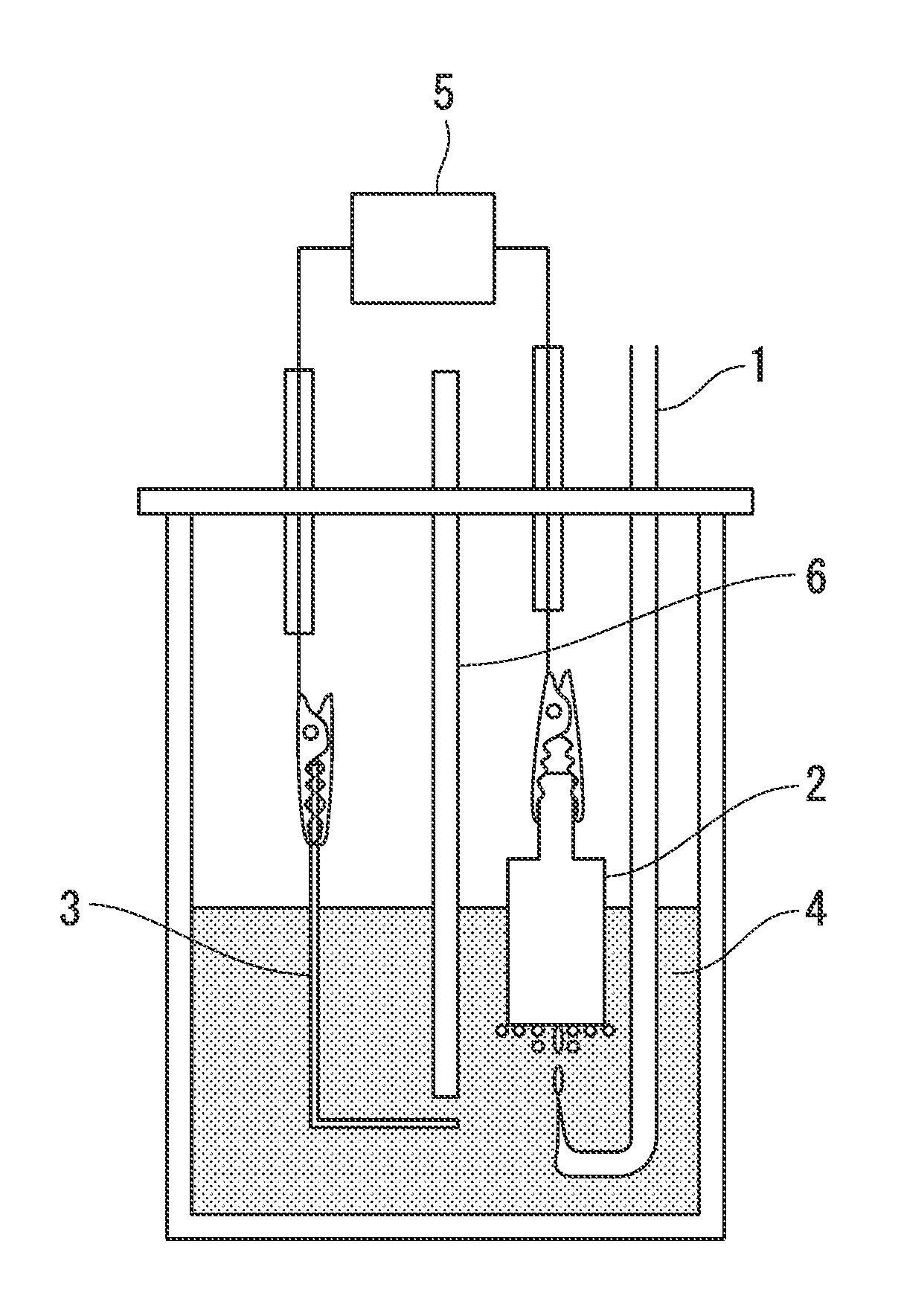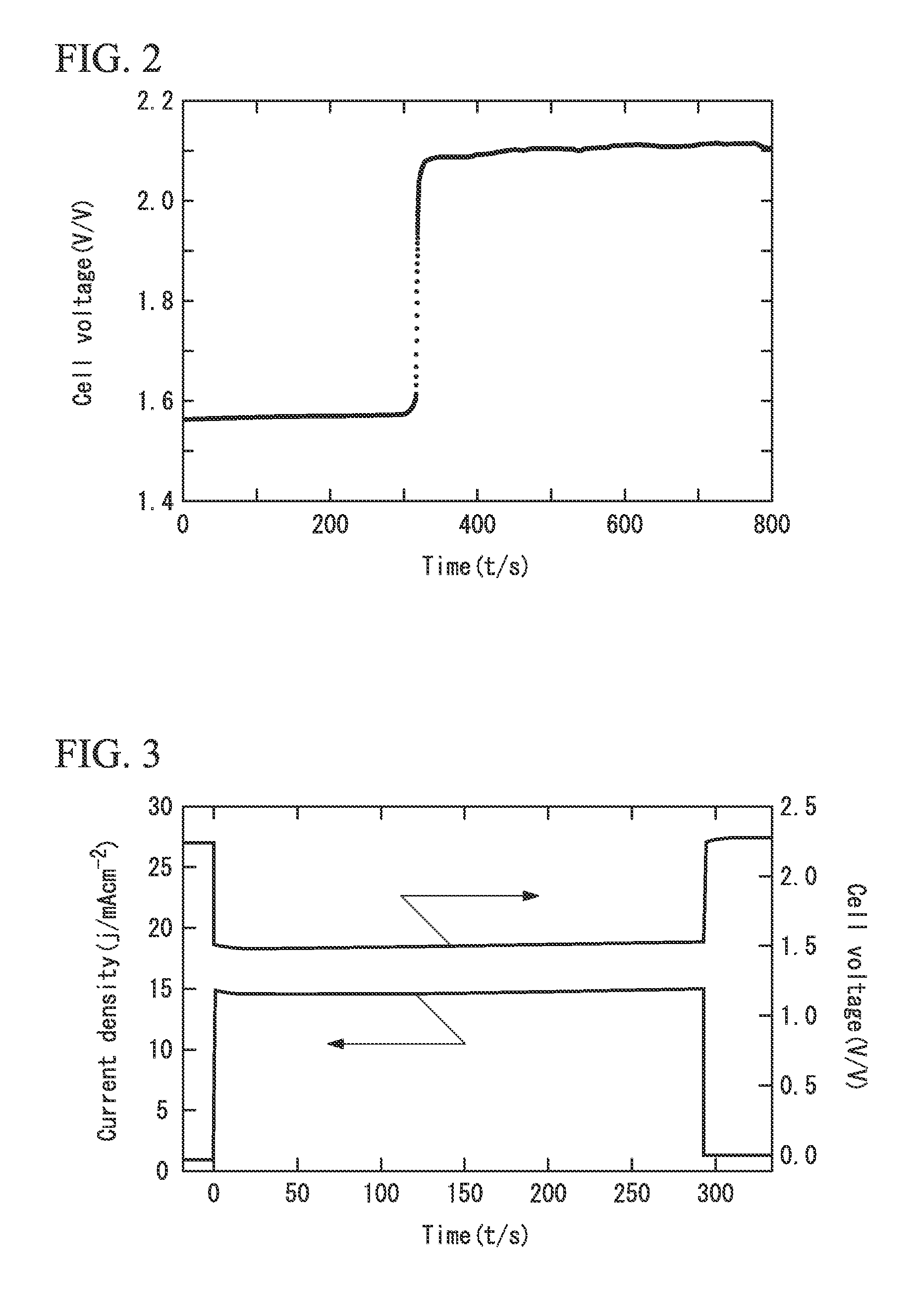Aluminum-halogen fuel cell
a fuel cell and halogen technology, applied in the field of fuel cells, can solve the problems of requiring a large amount of energy, requiring a large-scale apparatus, and a large amount of resistance, and achieve the effects of generating high-voltage electricity, simple solid-liquid separation operation, and reducing resistan
- Summary
- Abstract
- Description
- Claims
- Application Information
AI Technical Summary
Benefits of technology
Problems solved by technology
Method used
Image
Examples
example 1
[0060]FIG. 1 illustrates a fuel cell as one embodiment of the present invention. An electrode (aluminum electrode) formed from an aluminum metal plate having a purity of 99.999% that had been polished with a No. 1000 waterproof abrasive paper was used as the negative electrode 3. For the positive electrode 2, a graphite electrode was used (formed with a circular cylindrical shape such as that illustrated in FIG. 1 having a diameter of 15 mm and a surface area of 1.77 cm2, having a contact tab provided at the top, being substantially flat on the bottom surface, and having side surfaces that had been sealed with a Teflon (registered trademark) tape). For the electrolyte 4, 150 ml of an ionic liquid obtained by mixing 1-ethyl-3-methylimidazolium chloride and aluminum chloride in a molar ratio of 2:1 was used.
[0061]In order to prevent direct contact between the chlorine gas and the aluminum electrode, a polytetrafluoroethylene separator 6 was provided. The polytetrafluoroethylene separa...
example 2
[0063]With the exception of changing the positive electrode 2 to a graphite electrode having a circular cylindrical shape with a diameter of 21 mm and a surface area of 3.46 cm2, a fuel cell was assembled with the same structure as that described in Example 1.
[0064]The temperature of the ionic liquid was set to 30° C., 40° C., or 60° C., and at each temperature, the voltage between the aluminum electrode and the graphite electrode onto which the chlorine was being bubbled was adjusted to 0.5 V, and the current density was measured. The results revealed that the current density was 9.2 mAcm−2 at 30° C., 12.2 mAcm−2 at 40° C., and 23.7 mAcm−2 at 60° C.
example 3
[0065]With the exception of changing the positive electrode 2 to a graphite electrode having a circular cylindrical shape with a diameter of 21 mm and a surface area of 4.24 cm2, a fuel cell was assembled with the same structure as that described in Example 1. The bottom surface of the electrode included three parallel V-shaped grooves such as those illustrated in FIG. 4. The width of each groove was 3.3 mm, the length from the edge of the groove to the bottom thereof was 2.5 mm, the length of the middle groove was 21 mm, and the length of each of the left and right grooves was 18 mm.
[0066]In a similar manner to Example 2, the current density at a voltage of 0.5 V was measured when the temperature of the ionic liquid was either 30° C. or 40° C. The results revealed that the current density was 11.1 mAcm−2 at 30° C. and 14.3 mAcm−2 at 40° C.
PUM
 Login to View More
Login to View More Abstract
Description
Claims
Application Information
 Login to View More
Login to View More - R&D
- Intellectual Property
- Life Sciences
- Materials
- Tech Scout
- Unparalleled Data Quality
- Higher Quality Content
- 60% Fewer Hallucinations
Browse by: Latest US Patents, China's latest patents, Technical Efficacy Thesaurus, Application Domain, Technology Topic, Popular Technical Reports.
© 2025 PatSnap. All rights reserved.Legal|Privacy policy|Modern Slavery Act Transparency Statement|Sitemap|About US| Contact US: help@patsnap.com



